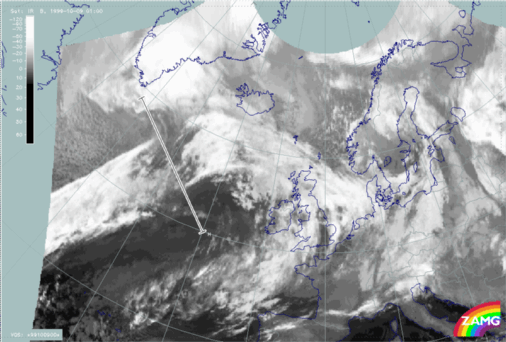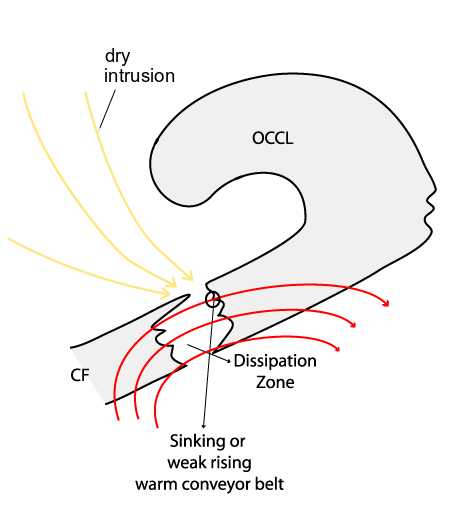Meteorological Physical Background
In general, the conveyor belt concept provides an excellent explanation for the decay of cloudiness within a frontal cloud band. Three synoptic situations, based on the source of the air masses transported by the relative streams, can be distinguished:
- The involvement of air rotating around the centre of a depression associated with the frontal system.
- A sinking relative stream (a cold conveyor belt or a dry intrusion) can be detected which flows at nearly right angles to the frontal cloud band at low to middle levels, leading to the characteristic decay of cloudiness.
- At upper levels, a sinking or only a very weakly rising warm conveyor belt can be observed.
The following figures show the relative streams of a case over the Atlantic when there is Frontal Decay occuring in air masses associated with the related system vortex:
|
09 October 1999/01.00 UTC - Meteosat IR image; position of vertical cross section indicated
|
09 October 1999/01.00 UTC - Vertical cross section; black: isentropes (THETAE), orange thin: IR pixel values, orange thick: WV pixel values
|
The left image above shows the decay zone of the Cold Front over the Atlantic. The selected vertical cross section is indicated by a white line and is also shown in the right image. The selection of the isentropic surfaces was made in order to get the best impression of the inflow at low and middle levels (316K) of the frontal gradient zone, as well as to get information about the behaviour of the warm conveyor belt at high levels (322K) within and above the frontal zone.
|
09 October 1999/01.00 UTC - Meteosat IR image; magenta: relative streams 300K - system velocity: 245° 17m/s, yellow: isobars 300K, position of vertical cross section indicated
|
09 October 1999/01.00 UTC - Meteosat IR image; magenta: relative streams 316K - system velocity: 245° 17m/s, yellow: isobars 316K, position of vertical cross section indicated
|
In the left image above, the upper relative stream at the 300K isentropic surface can be observed sinking from about 600 hPa down to about 800 hPa in the area of cloud dissipation. In the right image above, the corresponding warm conveyor belt can be observed with the relative stream approximately parallel to the isohypses and gently rising.
A distinction can be made between cases with rising and sinking warm conveyor belts. In the case of a rising warm conveyor belt any gap within the frontal cloud band will probably close again, while in case of a sinking warm conveyor belt a complete dissipation of cloud in the IR imagery is probable.
Rising warm conveyor belt:
|
09 October 1999/01.00 UTC - Meteosat IR image; magenta: relative streams 322K - system velocity: 245° 17m/s, yellow: isobars 322K, position of vertical cross section indicated
|
09 October 1999/11.00 UTC - Meteosat IR image
|
The left image above shows a weak rising warm conveyor belt at the isentropic surface at 322K over the area of decay. The right image shows that, 10 hrs later, the cloud gap has closed again.
Sinking warm conveyor belt:
|
28 August 2006/06.00 UTC - Vertical cross section; black: isentropes (ThetaE), orange thin: IR pixel values, orange thick: WV pixel
|
28 August 2006/06.00 UTC - Meteosat 8 IR10.8 image; magenta: relative streams 318K - system velocity: 289° 36m/s, yellow: isobars 318K; position of vertical cross section indicated
|
The right image above shows a sinking warm conveyor belt at the isentropic surface of 318K, which lies within the frontal gradient zone and inclined from about 400 hPa down to about 800 hPa over the area of the front decay. This situation results in a nearly complete dissipation of the cloud band, as seen in the IR10.8 image over Western France, some 12 hrs later (image below).
|
28 August 2006/18.00 UTC - Meteosat 8 IR10.8 image
|
About 70% of all investigated cases with inflow of air masses from within the system show an upper relative stream at lower levels and a warm conveyor belt (sinking or rising) at higher levels. Those cases are very similar to the conceptual sub model presented here. The remaining 30% show deviations from the concept (e.g. a dominating, sinking relative stream at all levels without any distinct warm conveyor belt at higher levels).
- The involvement of air masses originating from an area far behind the frontal system (e.g. because of a large low pressure system).
At low and middle levels there is a dry intrusion forming an acute angle with the frontal cloud band, together with a sinking or only very gently rising warm conveyor belt at higher levels above the zone of decay.
The following pictures display the relative streams of a case of a Cold Front over the eastern Atlantic when there is frontal dissolution in connection with air masses from far behind the system:
|
09 January 2007/12.00 UTC - Meteosat 8 IR10.8 image; position of vertical cross section indicated
|
09 January 2007/12.00 UTC - Vertical cross section; black: isentropes (ThetaE), orange thin: IR pixel values, orange thick: WV pixel values
|
The left image shows the cloud dissipation zone of the Cold Front east of Great Britain. The vertical cross section is indicated by a white line and is presented in the right image. The selection of the isentropic surfaces was made in order to get an impression of the situation within the frontal surface at low levels (308K), as well for the warm conveyor belt at higher levels (316K) within or above the frontal surface.
|
09 January 2007/12.00 UTC - Meteosat 8 IR10.8 image; magenta: relative streams 308K - system velocity: 313° 12m/s, yellow: isobars 308K; position of vertical cross section indicated
|
09 January 2007/12.00 UTC - Meteosat 8 IR10.8 image; magenta: relative streams 316K - system velocity: 313° 12m/s, yellow: isobars 316K; position of vertical cross section indicated
|
The left image above shows the distribution of relative streams at an isentropic surface of 308K. The upper relative streams with their origin in cold dry air from far behind the front sink rapidly from about 400 hPa down to about 600 hPa over the area of cloud decay. The warm conveyor belt at 316K gently sinks to about 400 hPa in the above right image.
The majority (60%) of all investigated cases with inflow of air from behind the system fit the model of a sinking upper relative stream at middle levels and a sinking or weakly rising warm conveyor belt very well. The remaining cases again show deviations from this conceptual sub model (e.g. a sinking warm conveyor belt at all levels and no upper relative stream).
- An inflow of air masses influenced by a second system immediately behind the front (e.g. Comma cloud or a cold air development).
- Only a few cases (5%) of this type are available. There seems to be a particular characteristic behaviour in the relative stream. A thick sinking relative stream (probably a dry intrusion) can be observed, crossing the frontal cloud band at an acute angle at all levels. There is no warm conveyor belt configuration associated with this type of Front Decay.
|
14 August 2000/18.00 UTC - Meteosat IR image; position of vertical cross section indicated
|
14 August 2000/18.00 UTC - Vertical cross section; black: isentropes (ThetaE), orange thin: IR pixel values, orange thick: WV pixel
|
The left image shows the dissolution zone of the Cold Front south west of Great Britain. The vertical cross section is indicated by a white line and is presented in the right image. The selection of the isentropic surface at 314K represents the typical distribution of the relative streams at all levels.
|
14 August 2000/18.00 UTC - Meteosat IR image; magenta: relative streams 314K - system velocity: 241° 14m/s, yellow: isobars 314K, position of vertical cross section indicated vertical cross section indicated
|
The Front Decay case in the above image shows an approaching Comma cloud (cold air development) to the rear of the frontal cloud band. The relative streams at the isentropic surface of 314K indicate a strong downward motion from 600 hPa to 800 hPa across the zone of decay. Considering the low number of cases of this type, it can be assumed that about 50% of cases show a sinking upper relative stream at all levels and, therefore, correspond to this third conceptual sub model. The remaining 50% show various deviations: e.g. a sinking or rising warm conveyor belt at higher levels, or the influence of a second approaching Cold Front leading to a saddle pattern in the relative streams over the zone of decay.
The sinking relative streams are well reflected in the temperature advection fields as distinct CA, which appears within as well as in front of the frontal cloud band. A sharp transition between WA and CA, crossing the frontal band perpendicularly, almost corresponds to the boundaries of the cloud gap.
|
08 June 2006/12.00 UTC - Meteosat 8 IR10.8 image; red dashed: temperature advection - CA 700 hPa, red solid: temperature advection - WA 700 hPa
|
Another aspect of the physical meteorological background relates to the upper level jet streak, and is described in the chapter addressing the conceptual model "front intensification by jet". Regarding the position to the jet streak, it is well known that the right entrance region and the left exit region are areas of frontal intensification combined with positive vorticity advection at high levels, with convergence and distinct upward motion at low and mid levels. On the other hand the left entrance region and the right exit region should lead to frontolysis or at least cloud dissolution in connection with negative vorticity advection at high levels, divergence and downward motion in middle levels.
On this basis a Front Decay would be expected in the right exit region, of a jet in an area of distinct downward motion, especially if there is an acute angle between the jet and the frontal cloud band. In reality, this was only found in 30% of all investigated cases. In the diagrams below the most probable area of Front Decay lies along the anticyclonic side of the jet, between the exit region and the jet core. If the process of downward motion over the cloud gap is fully mature, there should also be a distinct maximum of negative vorticity advection.




















